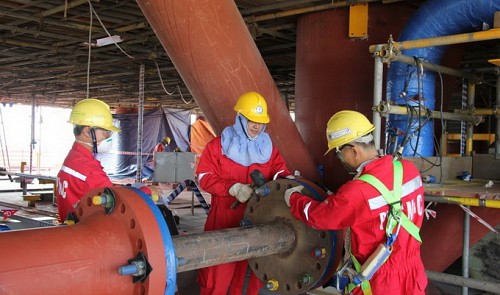Where there’s a will, there’s a way: Vietnam masters advanced oil rig building technology
Where there’s a will, there’s a way: Vietnam masters advanced oil rig building technology
By starting with foreign experts involved in oil rig construction projects, two Vietnamese companies have spared no effort to master the technology, and ended up being able to export giant platforms wholly made on their own.

PTSC Mechanical and Construction (PTSC M&C), the service arm of state-run Vietnam National Oil and Gas Group (PetroVietnam), and PV Shipyard, the shipbuilding unit of PetroVietnam, are vivid examples of Vietnamese engineers adapting to advanced technology.
Back before 2010, PTSC M&C used to leave the detailed design stage to foreign experts in every project it worked on.
“This increased the total expense,” director Do Xuan Thang said, adding that this was why the company set a target in 2009 that it must be able to settle the issue by 2015.
To that end, PTSC M&C invited international partners to train its engineers at the company’s headquarters in the southern coastal province of Ba Ria-Vung Tau. The Vietnamese and foreign engineers worked together on several projects, and the company managed to achieve the target one year earlier than expected.
In mid-2014, PTSC M&C engineers were able to complete the detailed design for the Su Tu Vang Tay Nam oil rig on their own.
Earlier that year, the company had also won a US$100 million contract to build an oil rig for the Maharaja Lela South (MLS) Project offshore Brunei from the investor Total E&P Borneo B.V.
The Vietnamese company is responsible for providing engineering, procurement, construction, and commissioning services for the platform, according to the EPC contract, which PTSC M&C said it had to beat many strong competitors to win.
PTSC M&C is working on the 1,500-ton topside of the rig at its yard in Vung Tau, a city in Ba Ria-Vung Tau, whereas construction of the 1,200-ton jacket was carried out in Brunei because the investor required that 50 percent of the project’s workforce be local personnel.
“It was really a huge challenge for us as there are very few skilled oil and gas laborers in Brunei,” Thang said of the requirement. “We had to send Vietnamese engineers and workers to Brunei to supervise, train and work with local workers.”
The Vietnamese firm has completed the jacket in Brunei and is moving on with the topside, Thang said, adding that the complete rig will be delivered in June as scheduled.
The director said being able to create the detailed design for the project brings in “numerous benefits and great economic effectiveness.”
“We can save millions of U.S. dollars by not having to hire foreign experts,” he said, adding that using the local workforce also helps the company detect and fix any problems immediately.
“The time to complete the jacket was thus shortened to only five months instead of up to 11 months, and ten months from the previous 18 months in the case of the topside,” he said.
“The loss ratio of the project also dropped to only five percent instead of 20-25 percent.”
In 2013 PTSC M&C also won a $70 million procurement and fabrication contract for the Heera Redevelopment project operated by India’s Oil and Natural Gas Corporation.
The Vietnamese company delivered the 8,500-ton topside in November 2014, and was praised by the project’s investor AFCONS as having completed the platform “professionally under international standards.”
PTSC M&C is pursuing many other megaprojects developed by such oil and gas giants as ONGC, Thailand’s PTT Public Company Limited, and Canadian Talisman Energy, and is upbeat that it can win the EPC contracts for them.
While PTSC M&C is reaping sweet fruits for its efforts, the PV Shipyard is also enjoying initial successes in its bid to master the leading-edge technology in building jackup rigs.
Defying pressure
A jackup rig, or a self-elevating unit, is a type of mobile platform that consists of a buoyant hull fitted with a number of movable legs, capable of raising its hull over the surface of the sea, freeing it from reliance on tugs or heavy lift ships for transportation.
In early 2012 PV Shipyard completed the Tam Dao 03 platform under a $190 million contract with Vietsovpetro, a joint Russian-Vietnamese enterprise which had previously had to import such platforms for oil and gas exploration.
This has added Vietnam to the list of a few countries that are able to make jackup rigs.
In October last year PV Shipyard started work on the $230 million Tam Dao 05 jackup rig for another contract it signed with Vietsovpetro.
The Tam Dao 03 and Tam Dao 05 are the combination of hundreds of different technical structures and 2,000 spare parts, according to PV Shipyard engineers.
“People were skeptical that a Vietnamese company would be able to make such a complicated platform, but we have defied pressure and achieved success,” general director Phan Tu Giang said.



















